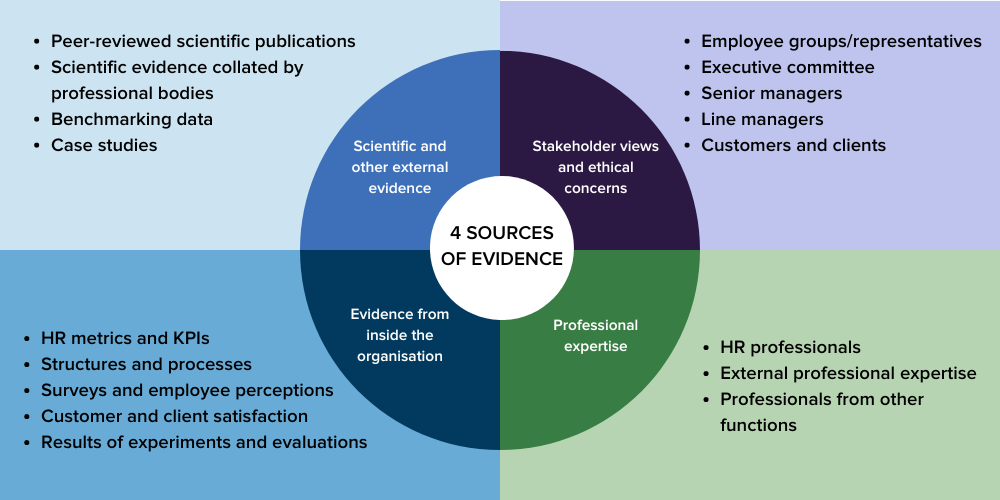An evidence-based approach allows HR practitioners to enhance decision-making, manage risk and increase their impact. What does this approach look like in practice, and how can HR get started?
With the HR function playing a more strategic role than ever in many organisations, the ability to make evidence-based decisions has quickly become a critical skill for practitioners.
As HR leaders know well, in an era defined by rapid change and disruption, the stakes are too high to rely on gut instinct alone. By grounding strategies in evidence, HR practitioners can offer clarity amid uncertainty and ensure their efforts are aligned with the broader business goals.
In recognition of this, recent years have seen the concept of ‘evidence-based HR’ (or EBHR) grow in popularity. Evidence-based HR is an approach that emphasises the use of data, research and empirical evidence to make decisions about HR practices and strategies.
The term has become increasingly recognised in the HR community, with many employers placing more focus on data-driven decision-making. The rise of AI and more sophisticated analytics tools has also made it easier to collect and analyse large amounts of HR-related data to inform an evidence-based HR practice.
According to Tanya Hammond FCPHR, Founder and Chief Collaborator at Tailored HR Solutions, while the increase in awareness of evidence-based HR is a welcome development, there is still some progress to be made in terms of how HR harnesses the right evidence in the right way.
“What we’re observing is that evidence still means ‘what we can get out of an HR system’,” she says. “But I think the world has evolved beyond saying that people analytics is something that’s purely systems-based – it’s way bigger than that.
“It’s about unlocking the data in the HR system, and being comfortable asking questions and considering the data against a variety of factors to draw out meaningful insights,” says Hammond, who will be speaking about reconfiguring a healthy, resilient and high-performing organisation fit for now and tomorrow at AHRI’s National Convention in August.
What does evidence-based HR look like?
One of the most important principles of evidence-based HR is to incorporate a variety of sources and forms of evidence into decision-making. Relying too heavily on one system or process as a single source of truth can prevent HR from noticing subtleties behind workforce trends.
“This will include unlocking relevant information from HR information systems, but also branching out further to leverage other sources of evidence, such as external expertise and research findings,” says Hammond.
In a report published last year, the Corporate Research Forum broke down the sources of evidence typically drawn on by a well-rounded, evidence-based HR practice into a four-part framework, as shown below:

As an example of evidence-based HR in action, picture a scenario where an organisation finds its employee engagement scores have declined significantly over the previous year.
Using the principles of EBHR, HR gathers data through engagement surveys, focus groups and individual interviews to understand the main drivers behind this decline.
They identify that employees feel a lack of recognition and growth opportunities. They then examine research on effective recognition programs and talent development initiatives and decide to pilot a new program focusing on employee recognition and career advancement.
The program tracks engagement metrics before and after its implementation, showing an improvement in employee engagement and satisfaction. HR then scales the program company-wide and continues to monitor its effectiveness through regular engagement surveys.
“Drawing on a broad range of evidence allows HR to effectively define the problem and help identify important nuances behind organisational opportunities, issues and trends,” says Jaye Matheson, Chief Insights and Transformation Expert at Tailored HR Solutions.
“People analytics or evidence-based HR is a method to uncover the root cause of an issue, and by gaining varied perspectives, you’re going to get better insights and a more impactful solution. Sometimes you need to slow down to speed up,” says Matheson, who is also speaking at AHRI’s National Convention and Exhibition.
Getting started with evidence-based HR
One thing that can hold HR practitioners back from embracing the shift towards EBHR is the misbelief that they need to be experts in data and analytics.
“In fact, many HR practitioners have the right capabilities, tools and resources to undertake EBHR, like problem-solving, a curious mind and strong business acumen – all foundational elements for effective HR decision-making,” says Matheson.
“Often, people want HR or people data to be perfect before they do anything,” she says. “But you can’t let perfection get in the way of making a start and delivering something impactful. If you want to run a marathon, you’ve got to start running.”
The more evidence HR is able to leverage, the more likely they are to uncover places where data is being reported inaccurately or inconsistently, and support continuous improvements.
“Instead of saying, ‘My headcount doesn’t line up,’ ‘My turnover numbers are wrong,’ and letting the conversation end there, we should be using this information holistically to help answer a question,” she says.
“When faced with inaccurate data, people often decide to stop there,” says Hammond.
“[Maybe] it’s wrong by two or three per cent because it’s live data, and it’s constantly changing. But even if it’s [slightly] wrong, a trend is a trend. And it’s not ‘wrong’ for the purpose in which we’re going to use it.”
“You can’t let perfection get in the way of making a start and delivering something impactful. If you want to run a marathon, you’ve got to start running.” – Jaye Matheson, Chief Insights and Transformation Expert at Tailored HR Solutions
Given the sheer volume of evidence considered in EBHR, both Hammond and Matheson advise HR to ensure they are dedicating enough time to assessing and acting on the information and insights.
“The tension is the desire to move quickly,” says Matheson. “There tends to be a bias to action. People tend to want to go forth and solve a problem.
“But, if they want to make the right decisions and know with confidence that they’re investing in the right initiatives to achieve their desired outcomes, they need to take the time to exercise diligence to fully examine the information from various different perspectives.”
Risks and ethical considerations
As with all branches of data collection and analysis, employers need to be aware of the relevant legal safeguards and their ethical responsibilities to their people.
“You need to understand the basic foundations of people analytics and the principles to make sure you’re thinking about data ethically,” says Matheson.
“[With evidence-based HR], the world is your oyster. But just because you can [use some sorts of information], it doesn’t mean you should.”
She recalls an example of a large organisation which, in an effort to optimise its supply chains, gave its employees wearable devices to track their work tasks. In addition, they also captured how long employees spent taking breaks, which was then used to manage employee performance.
This example demonstrates an instance where data can be collected to solve an intended problem (supply chain optimisation), but can also be used in a way that may contravene the original intent, leading to questions around the ethical use of data.
“Think about what information is going to have a positive impact on the business and a positive impact on the workforce,” she says.
The recent proliferation of new AI technologies means that HR is now able to gather and assess information at greater speed and volume than ever before. However, these machines cannot yet replace humans’ ability to think critically about data and spot ethical nuances like this.
As a result, getting the most out of this technology will mean striking a balance between harnessing its processing abilities and maintaining a critical human eye.
Given their expertise in all things people, HR is in a prime position to manage this balance, says Hammond.
“Ultimately, it’s about how we source the greatest people, and how we ensure that people perform at their best,” she says.
“If we don’t use evidence-based HR in the work that we do, then we’re not providing the services that are truly required – we’re not being that trusted, critical, credible partner that our organisations need.”
Understand the principles of data-driven decision making and learn to apply a data-driven mindset to HR strategies and challenges with AHRI’s short course in People Analytics.


This is a really nice explanation and demonstration of the use of evidence-based management in HR. I particularly like the way you advise to start doing some analyses of your data, even if it’s not perfect… don’t be scared of it But then to also use other information types available inside and outside the organisation. Yay to use of evidence-based management and HR.
Evidence based does not need to stop at internal data collection. The true meaning of Evidence Based would be to ensure that before we implement any program or strategy, that is evidence based (ie backed up by good research over a broad base of people, external to your organisation). The first thing that would then go is “Generation Theory”, which is so widely referenced in HR but has no valid research basis. This “theory” was dreamed up by a marketing team, and applies gross generalisations based on age alone. This is real Age Discrimination masquerading as management theory.